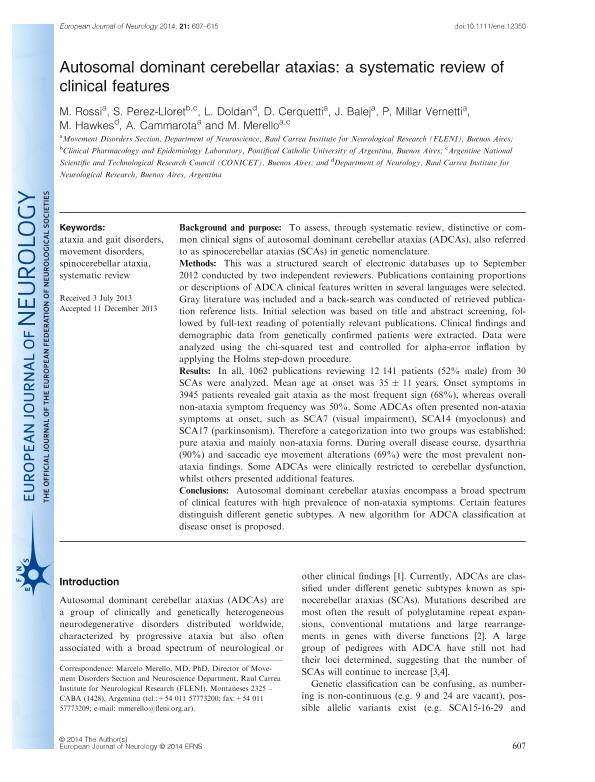Artículo
Autosomal dominant cerebellar ataxias: a systematic review of clinical features
Rossi, M.; Pérez Lloret, Santiago ; Doldan, L.; Cerquetti, Daniel; Balej, J.; Millar Vernetti, P.; Hawkes, M.; Cammarota, Adrian Aldo
; Doldan, L.; Cerquetti, Daniel; Balej, J.; Millar Vernetti, P.; Hawkes, M.; Cammarota, Adrian Aldo ; Merello, Marcelo Jorge
; Merello, Marcelo Jorge
 ; Doldan, L.; Cerquetti, Daniel; Balej, J.; Millar Vernetti, P.; Hawkes, M.; Cammarota, Adrian Aldo
; Doldan, L.; Cerquetti, Daniel; Balej, J.; Millar Vernetti, P.; Hawkes, M.; Cammarota, Adrian Aldo ; Merello, Marcelo Jorge
; Merello, Marcelo Jorge
Fecha de publicación:
02/2014
Editorial:
Wiley
Revista:
European Journal of Neurology
ISSN:
1351-5101
e-ISSN:
1468-1331
Idioma:
Inglés
Tipo de recurso:
Artículo publicado
Clasificación temática:
Resumen
BACKGROUND AND PURPOSE: To assess, through systematic review, distinctive or common clinical signs of autosomal dominant cerebellar ataxias (ADCAs), also referred to as spinocerebellar ataxias (SCAs) in genetic nomenclature.
METHODS: This was a structured search of electronic databases up to September 2012 conducted by two independent reviewers. Publications containing proportions or descriptions of ADCA clinical features written in several languages were selected. Gray literature was included and a back-search was conducted of retrieved publication reference lists. Initial selection was based on title and abstract screening, followed by full-text reading of potentially relevant publications. Clinical findings and demographic data from genetically confirmed patients were extracted. Data were analyzed using the chi-squared test and controlled for alpha-error inflation by applying the Holms step-down procedure.
RESULTS: In all, 1062 publications reviewing 12 141 patients (52% male) from 30 SCAs were analyzed. Mean age at onset was 35 ± 11 years. Onset symptoms in 3945 patients revealed gait ataxia as the most frequent sign (68%), whereas overall non-ataxia symptom frequency was 50%. Some ADCAs often presented non-ataxia symptoms at onset, such as SCA7 (visual impairment), SCA14 (myoclonus) and SCA17 (parkinsonism). Therefore a categorization into two groups was established: pure ataxia and mainly non-ataxia forms. During overall disease course, dysarthria (90%) and saccadic eye movement alterations (69%) were the most prevalent non-ataxia findings. Some ADCAs were clinically restricted to cerebellar dysfunction, whilst others presented additional features.
CONCLUSIONS: Autosomal dominant cerebellar ataxias encompass a broad spectrum of clinical features with high prevalence of non-ataxia symptoms. Certain features distinguish different genetic subtypes. A new algorithm for ADCA classification at disease onset is proposed.
Archivos asociados
Licencia
Identificadores
Colecciones
Articulos(OCA HOUSSAY)
Articulos de OFICINA DE COORDINACION ADMINISTRATIVA HOUSSAY
Articulos de OFICINA DE COORDINACION ADMINISTRATIVA HOUSSAY
Articulos(SEDE CENTRAL)
Articulos de SEDE CENTRAL
Articulos de SEDE CENTRAL
Citación
Rossi, M.; Pérez Lloret, Santiago; Doldan, L.; Cerquetti, Daniel; Balej, J.; et al.; Autosomal dominant cerebellar ataxias: a systematic review of clinical features; Wiley; European Journal of Neurology; 21; 4; 2-2014; 607-615
Compartir
Altmétricas



